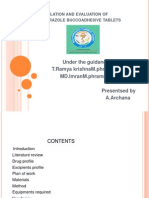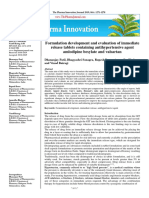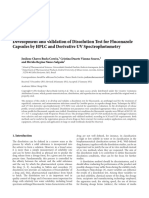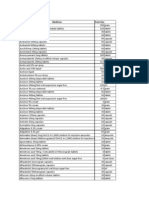463 PDF
463 PDF
Uploaded by
andypedeCopyright:
Available Formats
463 PDF
463 PDF
Uploaded by
andypedeOriginal Description:
Original Title
Copyright
Available Formats
Share this document
Did you find this document useful?
Is this content inappropriate?
Copyright:
Available Formats
463 PDF
463 PDF
Uploaded by
andypedeCopyright:
Available Formats
Jayanthi et al / IJRAP 2011, 2 (2) 577-580
Research Article Available online through
www.ijrap.net ISSN 2229-3566
pH-INDEPENDENT CONTROLLED RELEASE SWELLABLE MATRIX TABLETS
Jayanthi*, Mathews Rashmi, Bhaskaran Shyamala, Sateesha S.B., Abraham Sindhu
Nargund College of Pharmacy, Bangalore-85, Karnataka, India
Received on: 12/01/2011 Revised on: 12/03/2011 Accepted on: 25/03/2011
ABSTRACT
The aim of this study was to overcome pH-dependent release of weakly basic drug and to achieve pH-independent
drug release. An anti-hypertensive drug, Propranolol hydrochloride was chosen due to its pH- dependent solubility.
One of the approaches to solve the problem of pH-dependent release of weakly basic drug has been done in this work.
The water soluble and highly swellable HPMC was used as a matrix former and organic acids Citric acid and
Succinic acid were added to the drug polymer system in different formulations in varying proportions (at 10, 20, 40
and 80mg) as release modifiers. The addition of organic acids was found to maintain an acidic micro environmental
pH inside the polymer matrices during drug release in phosphate buffer pH 7.4. On the other hand, the amount of
each organic acid added to the system had no effect on the drug release in acidic solution 0.1N HCL. So the micro
environmental conditions for the dissolution and diffusion of drug were almost kept constant. Thus, the release of
Propranolol hydrochloride from tablets containing HPMC and organic acids was found to be pH-Independent.
Between the two organic acids, Succinic acid showed slightly better release when compared to Citric acid.
KEYWORDS: pH-independent, weakly basic drug, HPMC, solubility and swell-ability of HPMC.
*Corresponding Author
Jayanthi, Dept of Pharmaceutics, Nargund College of Pharmacy, Bangalore-85, Karnataka
E mail: jayanthia6@gmail.com
INTRODUCTION demonstrated in this work, i.e., using organic acids
Many drugs are weak bases or salts thereof and thus (Citric acid, Succinic acid) to create an acidic micro-
demonstrate pH dependent solubility in the pH range of environmental pH inside the polymer matrices5.
the GI tract1. With controlled release dosage forms, a Propranolol HCl is an adrenergic blocking agent,
possible pH-dependent release could result in in-vivo effective in treatment of hypertension and angina.
variability and bioavailability problems. Hence pH- Propranolol HCl has short plasma half-life of 3-5hrs
independent drug release is desirable to better assure a owing to which, multiple doses are needed to maintain
reliable drug therapy and to build a greater control into a therapeutic concentration of the drug in plasma for better
dosage form. therapeutic response and improved patient compliance.
Several attempts to overcome the problem of pH Therefore, it is necessary to develop sustained release
dependent solubility of weakly basic drugs have been preparations with extended clinical effects6, 7.
published2. They are mostly based on the presence of MATERIALS AND METHODS
acidic Excipients such as water-soluble or insoluble The materials used were procured from the following
polymers or organic acids3 that either increases the sources: Propranolol hydrochloride (Zydus Cadila
permeability of the drug delivery system by leaching out pharmaceuticals ltd. -Bangalore), Hydroxy propyl methyl
at higher pH-values or which keep the pH within the cellulose (HPMC, Methocelâ, K-15M, BPRL Pvt. Ltd.
system in the intestinal pH-range low and thus the Bangalore), Magnesium stearate (Loba chemie -
solubility of the drug high. Mumbai), lactose (Fast flow, Pharmatose, Nice
The objective of this study is to achieve a pH- chemicals) citric acid, Succinic acid (Nice chemicals-
independent release of a weakly basic drug from matrix Cochin) and all the other reagents used were laboratory
tablets consisting of HPMC, a swellable and water- grade. Magnesium stearate was used as lubricant. After
soluble polymer4. One of the approaches to overcome the evaluating the pre-compression parameters the lubricated
problem of pH-dependent drug release has been granules were compressed using 10-station Rimek mini-
International Journal of Research in Ayurveda & Pharmacy, 2(2), 2011 577-580
Jayanthi et al / IJRAP 2011, 2 (2) 577-580
press RSB-4 tablet punching machine using 8mm RESULTS AND DISCUSSION
diameter concave punches. The total weight of the tablet Propranolol HCl is a useful model drug to test the
was maintained at 250mg. The hardness of all the tablets formulation concept because of its distinct pH-dependent
was maintained to 4kg\cm2. solubility (mg).
Formulation of tablets The solubility of Propranolol HCl at pH 2.0 is
Weighed quantity of drug, polymer, organic acids (citric 120.5224mg/ml; at pH 3.6 it is 71.2462mg/ml, at pH 6.0
acid and Succinic acid) and diluents (lactose) were it decreases to about 63.5386 mg/ml and at basic pH 8.0
passed through sieve # 80 and mixed in geometric it reduces to 63.0042 mg/ml. Due to this pH-dependent
proportion using a mortar and pestle followed by solubility a remarkable difference in the resulting drug
lubrication using Magnesium stearate (0.5 %9)(table 1). release from HPMC tablet was observed in 0.1N HCl
250 mg of the lubricated physical mixture were and in Phosphate buffer pH 7.4 solutions.
compressed using a 10- station ‘Remek’ mini-press tablet Hydroxy Propyl Methyl cellulose polymer was used as a
punching machine using flat punches (8mm matrix former in which the drug Propranolol HCl was
diameter)3,8,9,10. Characteristics of the blend such as bulk embedded. The drug: polymer ratio were
density, compressibility index, and angle of repose were 1:1,1:1.5,1:2,1:2.5,1:3 for Hydroxy propyl methyl
determined for each formulation11, 12. cellulose polymer. The drug: polymer ratio of 1:3 was
Weight variation test was conducted as per specifications selected as an optimised formula. To this optimised
of IP. Hardness of the tablet was kept constant formula, organic acids such as citric acid and Succinic
(approximately 4 kg/cm2) for all the formulations. acid were added.
Evaluation of tablets: The tablets were subjected to In the case of highly swellable HPMC matrix tablets
various evaluation tests such as (Table-I formulation No. 5), approximately 7.7% and
1. Weight variation test: The tablets complied with the 4.6% of the drug was released after 1 hour in 0.1N HCl
I.P. requirements in the test for weight variation. and Phosphate buffer respectively. After 8 hours, 48% of
2. Friability test: less than 0.1% the drug was released in 0.1N HCl versus only 20% was
3. Drug content determination: released in Phosphate buffer solution, pH 7.4. (Shown in
The tablets were powdered, the tablet triturate equivalent graph 1).
to 40mg of propranolol HCL was taken in 100 ml The reason for this behaviour is that HPMC swells to a
volumetric flask, dissolved and volume was made up to significant extent upon contact with the release medium.
the mark with simulated gastric fluid. From this solution, The drug is not predominantly released by diffusion
0.5 ml was pipetted into a 50 ml volumetric flask and through water-filled pores but by diffusion through the
volume was made up to 50 ml with simulated gastric swollen polymer network. In addition the swelling of
fluid. The absorbance was measured at 216 nm against HPMC polymer matrix also plays an important role.
reagent blank (0.1 N HCl) using UV (Elico-SL159) Hence the approach to adjust the release profile of
spectrophotometer. . The procedure was repeated for four weakly basic drugs in Phosphate buffer to that in 0.1N
more tablets of the same formulation and the average HCl was based on the addition of organic acids to create
value of all five tablets was calculated. The drug content a constant acidic microenvironment inside the tablets.
was calculated using the following equation. Ideally, these acids should dissolve rather slowly to
Amount of drug present = Absorbance ± Intercept / slope remain within the tablet during the entire period of drug
´ Dilution Factor release independent of the pH value of the dissolution
In-vitro dissolution profile medium, the pH inside the tablet matrix was expected to
Dissolution studies were carried out by USP-Type II be acidic and thus the solubility of the weakly basic drug
method at 370 ± 0.50 C. The paddle was set to rotate at to be high. In this case, drug release should be pH-
50 rpm. One tablet, previously weighed, was kept in the independent. For this purpose, substances with high
dissolution media. The dissolution media, acidic buffer acidic strength (low pKa value) and relatively low
pH 1.2 for 12 hours and Phosphate buffer, pH 7.4 for 12 solubility in 0.1N HCl are suitable. Citric acid and
hours were used. 5ml of samples were withdrawn at Succinic acids were selected. In addition, the organic
each hour with replacement and diluted to 50ml and acids can act as pore-formers at high pH values.
absorbance was measured at 216nm in a UV (Elico- The addition of organic acids to HPMC-based matrix
SL159) spectrophotometer.13, 14,15 systems significantly increased the drug release in
Phosphate buffer (pH 7.4) with increasing amount of
organic acids (10 to 80 mg). The resulting release
profiles almost overlapped with the ones in 0.1N HCl.
International Journal of Research in Ayurveda & Pharmacy, 2(2), 2011 577-580
Jayanthi et al / IJRAP 2011, 2 (2) 577-580
This is in good agreement with above described REFERENCES
hypothesis of a constant micro-environmental pH within 1. Mooney KG, Mittun MA, Himmelstein KJ and Stella VJ.
Dissolution Kinetics of Carboxylic Acids II: Effect of Buffers. J.
the tablets. Pharm. Sci, 1981; 70(1): 201
The amount of organic acids added to the system had no 2. Streubel A, Siepmann J, Dashevsky A, Bodmeier R. pH-
effect on the drug release rate in 0.1N HCl. The independent release of weakly basic drug from water insoluble
explanation for this phenomenon might be as follows. and water soluble matrix tablets. J. Control. Rel .2001; 67: 101-
The polymer HPMC swells to a significant extent upon 110
3. Guajie XU and Hisakazu Sunada. Influence of formulation on
contact with release medium and hence the water filled drug Release Kinetics from Hydroxy propyl methyl cellulose
pores are rapidly closed due to the swelling of the Matrix Tablets”. Chem. Pharm. Bull. 1995; 43(3): 483 – 487
hydrogel. But the amount of imbibing bulk fluid is much 4. Rogelio Espinoza, Enrique Hong, Leopoldo Villafuerte,
higher in case of Phosphate buffer pH 7.4; this leads to “Influence of admixed Citric acid on the release profile of
higher amount of hydroxide ions entering the tablet, Pelanserin hydrochloride from HPMC matrix tablets”. Int. J.
Pharm., 2000;:201: 165–173
resulting in higher micro environment pH values lead to 5. Joel G, Hardmen, Lee, E limbird, Goodman and Gilman’s The
higher solubility of the organic acids. Hence creation of Pharmacological basis of therapeutics. 10th edition. Mc Graw
additional water filled pores and thus to higher force for Hill.
diffusion with increasing amount of incorporated organic 6. Naonari Kohri, Hiroshi Yatabe, Ken Iseki and Katsumi
acids (The formation of water-filled pores increases and Miyazaki. A New Type of pH-independent Controlled release
tablet. Int J. of Pharm 1991; 68:255-264
thus the resulting release rate increases). Furthermore,
7. Khattar D, Ahuja A, Khar RK. Hydrodynamically Balanced
the effect of the organic acid was investigated .In all the Systems of Sustained Release Dosage Forms for Propranolol
case the addition of organic acid lead to a significant Hydrochloride. Pharmazie, 1990; 45(5): 356-8
increase in drug release in Phosphate buffer pH 7.4. 8. Ainely Wade, Paul J Weller. Handbook of Pharmaceutical
However, when compared to citric acid, Succinic acid Excipients. 2nd Edition. The Pharmaceutical Press: London;
1994.
based formulation shows slight increase in the drug
9. Atherden M Bentley and Driver’s Textbook of Pharmaceutical
release rate, which may be attributed to the lower pKa Chemistry, 8th Edition 2002
value of Succinic acid. 10. Bettini R, Catellani PL, Santi P, Massimo G, Peppas N.A,
CONCLUSION Colombo P. Translocation of drug particles in HPMC matrix gel
The use of HPMC matrices makes possible a sustained layer: Effect of drug solubility and influence on release rate
release of Propranolol hydrochloride with coupled Journ. of Controlled Release 2001; 70: 383-91.
11. USPXXVI, U S Pharmacopoeial Convention, Inc. 2003.
dissolution mechanism of diffusion and essentially 12. British Pharmacopoeia London: Pharmaceutical Press; 2003
independent of pH. The addition of Succinic acid 13. Shyamala Bhaskaran and M. Remiz, Novel Approach to Zero
resulted in a slight increase in the drug release in Order Drug Delivery via hydrogel for Diltiazem hydrochloride,
phosphate buffer pH 7.4 when compared to citric acid, Indian J. Pharm. Sci., 2002; 64(4): 357 – 361
which could be attributed to the lower pKa value of 14. Seetharamappa J, Aparna G. Spectrophotometric determination
of Propranolol Hydrochloride in Pharmaceutical Preparations.
Succinic acid. Ind, J. Pharm. Sci., 2002; 63(1):201
Table 1: Tablet formulations
FORMULATION INGREDIENTS*
Formulation Propranolol HPMC Lactose Magnesium Citric Succinic
Code Hydrochloride 4000 CPS stearate acid acid
F1 40 40 168.5 1.5 - -
F2 40 60 148.5 1.5 - -
F3 40 80 128.5 1.5 - -
F4 40 100 108.5 1.5 - -
F5 40 120 88.5 1.5 - -
FC10 40 120 78.5 1.5 10 -
FC20 40 120 68.5 1.5 20 -
FC40 40 120 48.5 1.5 40 -
FC80 40 120 8.5 1.5 80 -
FS10 40 120 78.5 1.5 - 10
FS20 40 120 68.5 1.5 - 20
FS40 40 120 48.5 1.5 - 40
FS80 40 120 8.5 1.5 - 80
*All quantities are in milligrams/tablet
International Journal of Research in Ayurveda & Pharmacy, 2(2), 2011 577-580
Jayanthi et al / IJRAP 2011, 2 (2) 577-580
Graph 1
IN VITRO RELEASE PROFILE OF FORMULATION F5 - pH 1.2 & 7.4
Time (hrs) à
Graph 2
IN VITRO DISSOLUTION PROFILE OF FORMULATIONS FS10, FS20, FS40, FS80
Source of support: Nil, Conflict of interest: None Declared
International Journal of Research in Ayurveda & Pharmacy, 2(2), 2011 577-580
You might also like
- NURSING CARE PLAN - Myocardial Infarction Assessment Diagnosis Inference Planning Intervention Rationale Evaluation0% (1)NURSING CARE PLAN - Myocardial Infarction Assessment Diagnosis Inference Planning Intervention Rationale Evaluation4 pages
- Formulation Development and Evaluation of Pantoprazole Delayed Release Tablets0% (1)Formulation Development and Evaluation of Pantoprazole Delayed Release Tablets13 pages
- Biopharmaceutics & Pharmacokinetics Practical ManualNo ratings yetBiopharmaceutics & Pharmacokinetics Practical Manual74 pages
- Formulation and in Vitro Evaluation of Lansoprazole MicropelletsNo ratings yetFormulation and in Vitro Evaluation of Lansoprazole Micropellets11 pages
- Development of Chemically Modified Pectin Based Extended Release Tablets of NifedipineNo ratings yetDevelopment of Chemically Modified Pectin Based Extended Release Tablets of Nifedipine16 pages
- Design, Development of Formulation of Eperisone Hydrochrodide Floating Sustain Realease Tablet and Its EvaluationNo ratings yetDesign, Development of Formulation of Eperisone Hydrochrodide Floating Sustain Realease Tablet and Its Evaluation22 pages
- Preparation and Evaluation of Sustained Release Aminophylline TabletNo ratings yetPreparation and Evaluation of Sustained Release Aminophylline Tablet10 pages
- In Vitro Studies of Amlodipine Besylate Tablet and Comparison WithNo ratings yetIn Vitro Studies of Amlodipine Besylate Tablet and Comparison With7 pages
- Journal of Drug Delivery and TherapeuticsNo ratings yetJournal of Drug Delivery and Therapeutics7 pages
- Effect of Superdisintegrating Agent and Osmogens On Ciprofloxacin Loaded Naturally Occurring Biodegradable Coated Tablets For Colon TargetingNo ratings yetEffect of Superdisintegrating Agent and Osmogens On Ciprofloxacin Loaded Naturally Occurring Biodegradable Coated Tablets For Colon Targeting6 pages
- Formulation Development and Evaluation of Immediate Release Tablets Containing Antihypertensive Agent Amlodipine Besylate and ValsartanNo ratings yetFormulation Development and Evaluation of Immediate Release Tablets Containing Antihypertensive Agent Amlodipine Besylate and Valsartan8 pages
- Formulation and Evaluation of Floating Tablet of Captopril: Sameer Singh, Kalpana Prajapati, A K Pathak, A MishraNo ratings yetFormulation and Evaluation of Floating Tablet of Captopril: Sameer Singh, Kalpana Prajapati, A K Pathak, A Mishra9 pages
- Solubility Evaluations of Osimertinib Mesylate in Physiological BuffersNo ratings yetSolubility Evaluations of Osimertinib Mesylate in Physiological Buffers6 pages
- Formulation and Characterization of Floating Sodium Alginate Beads of Amoxicillin For Prolonged Gastric RetentionNo ratings yetFormulation and Characterization of Floating Sodium Alginate Beads of Amoxicillin For Prolonged Gastric Retention8 pages
- Formulation Optimization and Evaluation of Orodispersible Tablets of An Antipsychotic Drug Using Solubility Enhancement TechniqueNo ratings yetFormulation Optimization and Evaluation of Orodispersible Tablets of An Antipsychotic Drug Using Solubility Enhancement Technique25 pages
- Formulation & Evaluation of Floatable Insitu Gel For Stomach-Specific Drug Delivery of OfloxacinNo ratings yetFormulation & Evaluation of Floatable Insitu Gel For Stomach-Specific Drug Delivery of Ofloxacin15 pages
- Development and Evaluation of Buccoadhesive Propranolol Hudrochloride Tablet Formulations Effect of FillersNo ratings yetDevelopment and Evaluation of Buccoadhesive Propranolol Hudrochloride Tablet Formulations Effect of Fillers7 pages
- Formulation Optimization and Study On Effect of Penetration Enhancers On Reservoir Transdermal Therapeutic Systems of Hydralazine HydrochlorideNo ratings yetFormulation Optimization and Study On Effect of Penetration Enhancers On Reservoir Transdermal Therapeutic Systems of Hydralazine Hydrochloride6 pages
- Biopharmaceutics Classification System An Industrial ExperienceNo ratings yetBiopharmaceutics Classification System An Industrial Experience10 pages
- Available Online Through: ISSN 2321 - 6328No ratings yetAvailable Online Through: ISSN 2321 - 63287 pages
- Surfactant-Assisted Wet Granulation: A Simpler Approach To Improve Solubility and Sustain Ketoprofen ReleaseNo ratings yetSurfactant-Assisted Wet Granulation: A Simpler Approach To Improve Solubility and Sustain Ketoprofen Release11 pages
- Development and Optimization of Fast Dissolving Tablet of Levocetrizine HCLNo ratings yetDevelopment and Optimization of Fast Dissolving Tablet of Levocetrizine HCL10 pages
- Formulation Development and Evaluation of Famotidine Floating TabletNo ratings yetFormulation Development and Evaluation of Famotidine Floating Tablet6 pages
- Determination of Chlorogenic Acid, Baicalin and Forsythin in Shuanghuanglian Preparations by Hplc-DadNo ratings yetDetermination of Chlorogenic Acid, Baicalin and Forsythin in Shuanghuanglian Preparations by Hplc-Dad6 pages
- Rabeprazole: A Pharmacologic and Clinical Review For Acid-Related DisordersNo ratings yetRabeprazole: A Pharmacologic and Clinical Review For Acid-Related Disorders8 pages
- Practical Handbook of Pharmaceutical Chemistry for M.PharmFrom EverandPractical Handbook of Pharmaceutical Chemistry for M.PharmNo ratings yet
- Psychotherapy For Children and Adolescents Directions For Research and Practice100% (3)Psychotherapy For Children and Adolescents Directions For Research and Practice319 pages
- Improving Climber Flexibility: Climbers' CornerNo ratings yetImproving Climber Flexibility: Climbers' Corner3 pages
- APA Perioperative Fluid Management 2007No ratings yetAPA Perioperative Fluid Management 200737 pages
- The Psychology of Scent - Aromachology: Client Ref. KJSNo ratings yetThe Psychology of Scent - Aromachology: Client Ref. KJS1 page
- NURSING CARE PLAN - Myocardial Infarction Assessment Diagnosis Inference Planning Intervention Rationale EvaluationNURSING CARE PLAN - Myocardial Infarction Assessment Diagnosis Inference Planning Intervention Rationale Evaluation
- Formulation Development and Evaluation of Pantoprazole Delayed Release TabletsFormulation Development and Evaluation of Pantoprazole Delayed Release Tablets
- Biopharmaceutics & Pharmacokinetics Practical ManualBiopharmaceutics & Pharmacokinetics Practical Manual
- Formulation and in Vitro Evaluation of Lansoprazole MicropelletsFormulation and in Vitro Evaluation of Lansoprazole Micropellets
- Development of Chemically Modified Pectin Based Extended Release Tablets of NifedipineDevelopment of Chemically Modified Pectin Based Extended Release Tablets of Nifedipine
- Design, Development of Formulation of Eperisone Hydrochrodide Floating Sustain Realease Tablet and Its EvaluationDesign, Development of Formulation of Eperisone Hydrochrodide Floating Sustain Realease Tablet and Its Evaluation
- Preparation and Evaluation of Sustained Release Aminophylline TabletPreparation and Evaluation of Sustained Release Aminophylline Tablet
- In Vitro Studies of Amlodipine Besylate Tablet and Comparison WithIn Vitro Studies of Amlodipine Besylate Tablet and Comparison With
- Effect of Superdisintegrating Agent and Osmogens On Ciprofloxacin Loaded Naturally Occurring Biodegradable Coated Tablets For Colon TargetingEffect of Superdisintegrating Agent and Osmogens On Ciprofloxacin Loaded Naturally Occurring Biodegradable Coated Tablets For Colon Targeting
- Formulation Development and Evaluation of Immediate Release Tablets Containing Antihypertensive Agent Amlodipine Besylate and ValsartanFormulation Development and Evaluation of Immediate Release Tablets Containing Antihypertensive Agent Amlodipine Besylate and Valsartan
- Formulation and Evaluation of Floating Tablet of Captopril: Sameer Singh, Kalpana Prajapati, A K Pathak, A MishraFormulation and Evaluation of Floating Tablet of Captopril: Sameer Singh, Kalpana Prajapati, A K Pathak, A Mishra
- Solubility Evaluations of Osimertinib Mesylate in Physiological BuffersSolubility Evaluations of Osimertinib Mesylate in Physiological Buffers
- Formulation and Characterization of Floating Sodium Alginate Beads of Amoxicillin For Prolonged Gastric RetentionFormulation and Characterization of Floating Sodium Alginate Beads of Amoxicillin For Prolonged Gastric Retention
- Formulation Optimization and Evaluation of Orodispersible Tablets of An Antipsychotic Drug Using Solubility Enhancement TechniqueFormulation Optimization and Evaluation of Orodispersible Tablets of An Antipsychotic Drug Using Solubility Enhancement Technique
- Formulation & Evaluation of Floatable Insitu Gel For Stomach-Specific Drug Delivery of OfloxacinFormulation & Evaluation of Floatable Insitu Gel For Stomach-Specific Drug Delivery of Ofloxacin
- Development and Evaluation of Buccoadhesive Propranolol Hudrochloride Tablet Formulations Effect of FillersDevelopment and Evaluation of Buccoadhesive Propranolol Hudrochloride Tablet Formulations Effect of Fillers
- Formulation Optimization and Study On Effect of Penetration Enhancers On Reservoir Transdermal Therapeutic Systems of Hydralazine HydrochlorideFormulation Optimization and Study On Effect of Penetration Enhancers On Reservoir Transdermal Therapeutic Systems of Hydralazine Hydrochloride
- Biopharmaceutics Classification System An Industrial ExperienceBiopharmaceutics Classification System An Industrial Experience
- Surfactant-Assisted Wet Granulation: A Simpler Approach To Improve Solubility and Sustain Ketoprofen ReleaseSurfactant-Assisted Wet Granulation: A Simpler Approach To Improve Solubility and Sustain Ketoprofen Release
- Development and Optimization of Fast Dissolving Tablet of Levocetrizine HCLDevelopment and Optimization of Fast Dissolving Tablet of Levocetrizine HCL
- Formulation Development and Evaluation of Famotidine Floating TabletFormulation Development and Evaluation of Famotidine Floating Tablet
- Determination of Chlorogenic Acid, Baicalin and Forsythin in Shuanghuanglian Preparations by Hplc-DadDetermination of Chlorogenic Acid, Baicalin and Forsythin in Shuanghuanglian Preparations by Hplc-Dad
- Rabeprazole: A Pharmacologic and Clinical Review For Acid-Related DisordersRabeprazole: A Pharmacologic and Clinical Review For Acid-Related Disorders
- A Comprehensive Book on Experimental PharmaceuticsFrom EverandA Comprehensive Book on Experimental Pharmaceutics
- Practical Handbook of Pharmaceutical Chemistry for M.PharmFrom EverandPractical Handbook of Pharmaceutical Chemistry for M.Pharm
- Psychotherapy For Children and Adolescents Directions For Research and PracticePsychotherapy For Children and Adolescents Directions For Research and Practice
- The Psychology of Scent - Aromachology: Client Ref. KJSThe Psychology of Scent - Aromachology: Client Ref. KJS

























































































